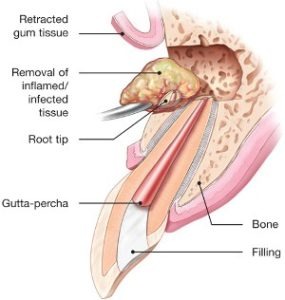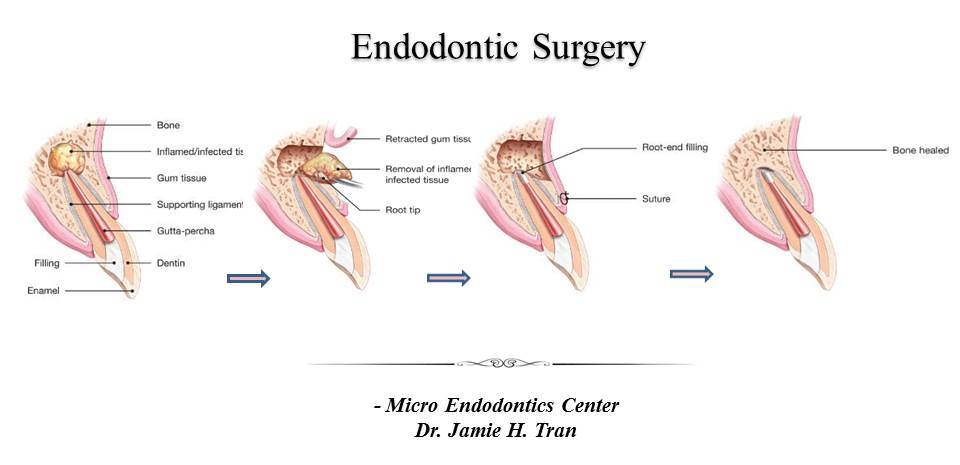Understanding Endodontic Surgery: When Is It Needed?
You may be wondering if endodontic surgery is really necessary.
After all, isn’t a root canal treatment enough to fix any dental issues?
While root canal treatments are highly effective, there are certain situations where surgery becomes the preferred option.
Understanding the factors that lead to the need for endodontic surgery is crucial in order to make informed decisions about your dental health.
So, let’s explore the different scenarios where endodontic surgery may be needed and why it could be the best solution for your specific dental condition.
Failed Root Canal Treatments
If you’ve experienced a root canal treatment that didn’t successfully address your dental issue, you may be wondering what options are available to rectify the situation. It can be frustrating to go through the pain and discomfort of a failed root canal treatment, but there’s hope.
One option that you may consider is endodontic surgery. Endodontic surgery, also known as apical surgery or root-end resection, is a procedure that’s performed when a traditional root canal treatment has failed to effectively treat the problem. This surgery aims to remove any infection or diseased tissue that may be present in the root canal system.
It involves making a small incision in the gum tissue near the tooth and accessing the root canal from the tip of the root. The endodontist then removes the infected tissue, cleans and shapes the root canal, and seals it with a filling material.
Endodontic surgery is typically recommended in cases where a root canal retreatment isn’t feasible or has a limited chance of success. It can also be used to treat certain conditions such as root fractures, persistent abscesses, and calcium deposits in the root canal system. However, it’s important to note that not all failed root canal treatments require surgery.
Your endodontist will evaluate your specific case and recommend the most appropriate treatment option for you.
Cracked Teeth
Cracked teeth can be a painful and concerning dental issue that requires prompt attention and treatment. If you have a cracked tooth, it’s important to understand the potential causes and symptoms, as well as the available treatment options.
There are several reasons why a tooth may crack. One common cause is trauma, such as a blow to the face or a fall. Chewing on hard objects like ice, nuts, or hard candy can also lead to tooth fractures. Additionally, teeth weakened by large fillings or root canal treatments are more prone to cracking. Regardless of the cause, a cracked tooth can be quite uncomfortable, causing sensitivity to hot or cold temperatures, pain when chewing, and even swelling in the surrounding gum tissue.
When it comes to treating a cracked tooth, the exact approach will depend on the severity and location of the crack. In some cases, a simple dental filling may be sufficient to repair the tooth. However, for more extensive cracks that involve the tooth’s pulp or root, endodontic surgery may be necessary. This specialized procedure, known as apicoectomy, involves removing the infected tissue and sealing the root to prevent further damage.
Persistent Infections
Persistent infections in a cracked tooth can lead to severe pain and require immediate attention. When an infection persists despite conventional treatments, endodontic surgery may be necessary to address the underlying issue.
Here are three reasons why persistent infections may occur and why surgery could be the best solution:
1. Incomplete removal of infected tissue: Sometimes, during a root canal procedure, not all infected tissue can be completely removed. This can result in the reoccurrence of infection and the need for surgical intervention.
2. Complex root anatomy: Some teeth have intricate root structures that can make it difficult to clean and disinfect thoroughly. In such cases, surgery allows the endodontist to access the root canals more effectively and eliminate the infection-causing bacteria.
3. Hidden fractures or canals: Cracks or hidden canals in the tooth can provide a hiding place for bacteria, making it challenging to eradicate the infection. Endodontic surgery can help locate and treat these hidden areas, promoting complete healing.
Dental Trauma
Now let’s talk about dental trauma.
Dental trauma can be caused by various factors, such as accidents, sports injuries, or biting down on hard objects.
If you experience dental trauma, you may notice signs like tooth fractures, loosening, or displacement.
It’s important to seek immediate treatment options to prevent further damage and restore the health of your teeth.
Causes of Dental Trauma
In cases of dental trauma, various factors can lead to injury or damage to the teeth. Understanding these causes can help you take preventive measures to protect your teeth.
Here are three common causes of dental trauma:
1. Accidents or falls: Falls or accidents, especially during sports activities or high-impact contact sports, can cause dental trauma. A blow to the mouth or face can result in fractures, dislodged teeth, or even complete tooth loss.
2. Biting on hard objects: Chewing on hard objects like ice, pens, or popcorn kernels can cause dental trauma. The excessive force exerted on the teeth can lead to cracks, chips, or fractures.
3. Motor vehicle accidents: Car accidents can cause significant trauma to the mouth and teeth. The impact from a collision can result in broken or displaced teeth, jaw fractures, or damage to the surrounding structures.
Signs and Symptoms
If you experience dental trauma, it’s important to be aware of the signs and symptoms that may indicate an injury or damage to your teeth.
One common sign is tooth sensitivity or pain, especially when biting or chewing. You may also notice swelling or tenderness in the affected area, along with bleeding or a change in the color of your tooth.
If your tooth becomes loose or starts to shift position, it could be a sign of dental trauma. Additionally, cracked or fractured teeth, as well as missing or broken pieces of tooth, are clear indications that an injury has occurred.
It’s crucial to seek dental attention immediately if you notice any of these signs or symptoms, as prompt treatment can help prevent further complications.
Treatment Options
To address dental trauma, there are various treatment options available that can help alleviate pain and restore the health of your teeth. Here are three treatment options that you should be aware of:
1. Root canal therapy: This is a common treatment for dental trauma that involves removing the infected pulp from the tooth and filling it with a special material. Root canal therapy can effectively relieve pain and save your tooth from extraction.
2. Dental crowns: If your tooth is severely damaged or fractured due to trauma, a dental crown may be recommended. A crown is a custom-made cap that covers the entire tooth, providing protection and restoring its strength and appearance.
3. Dental implants: In cases where the tooth can’t be saved, dental implants offer a permanent solution. Implants are titanium posts that are surgically placed into the jawbone, providing a strong foundation for a replacement tooth.
Deep Decay
If you have deep decay in your tooth, it can lead to severe tooth damage. This decay can reach the innermost part of the tooth, causing a root canal infection.
In some cases, deep decay can also cause a tooth fracture, making it necessary to consider endodontic surgery.
Severe Tooth Damage
Severe tooth damage due to deep decay often requires endodontic surgery to effectively treat the issue. When the decay reaches a point where it has severely damaged the tooth structure, other treatment options may not be sufficient to save the tooth. Here are three reasons why endodontic surgery may be necessary in cases of severe tooth damage:
1. Removal of infection: Endodontic surgery allows the dentist to access the root canal system and remove any infected tissue, bacteria, or debris that may be causing the severe damage. This helps to eliminate the source of infection and promotes healing.
2. Repairing fractures: In cases where the tooth has suffered fractures or cracks, endodontic surgery can be used to repair and strengthen the tooth structure. This can help prevent further damage and improve the long-term prognosis of the tooth.
3. Preserving the tooth: Endodontic surgery aims to save the natural tooth by addressing the underlying issues causing the severe damage. By preserving the tooth, patients can avoid the need for extraction and the potential complications associated with tooth loss.
Root Canal Infection
When deep decay progresses to a root canal infection, endodontic surgery may be necessary to effectively treat the issue.
A root canal infection occurs when bacteria enter the innermost part of the tooth, called the pulp, causing it to become inflamed and infected. This can happen due to untreated cavities, cracked teeth, or previous dental procedures.
If left untreated, a root canal infection can lead to severe pain, swelling, and the formation of abscesses.
Endodontic surgery aims to remove the infected pulp, clean the root canals, and seal them to prevent further infection. The procedure involves making a small incision in the gum tissue to access the tooth root, allowing the dentist to remove the infected tissue and restore oral health.
Tooth Fracture
Tooth fractures caused by deep decay require prompt attention to prevent further damage and preserve oral health. When a tooth is severely decayed, it becomes weak and more susceptible to fractures. If you experience a tooth fracture due to deep decay, it’s essential to seek dental treatment immediately.
Here are three reasons why addressing a tooth fracture caused by deep decay is crucial:
1. Prevents infection: A fractured tooth provides an entry point for bacteria, increasing the risk of infection. Prompt treatment can prevent the spread of infection to the surrounding tissues and bone.
2. Preserves the tooth: By addressing the fracture early on, your dentist can determine the best course of action to save the tooth. This may involve procedures such as a root canal or dental crown.
3. Relieves pain: Tooth fractures can be extremely painful, causing sensitivity to hot and cold temperatures. Seeking treatment promptly can alleviate discomfort and restore your oral health.
Root Resorption
Root resorption can occur when the cells responsible for breaking down old root structures become overactive. This process can be triggered by various factors, such as trauma, infection, or orthodontic treatment. When root resorption happens, the body’s own cells start to break down the root structure, leading to the loss of tooth structure.
There are two types of root resorption: internal and external.
Internal root resorption occurs when the resorptive process starts from within the pulp chamber and extends towards the root surface. This type of resorption is often asymptomatic and can only be detected through dental radiographs.
On the other hand, external root resorption occurs when the resorptive process starts from the outer surface of the root and progresses towards the inner part of the tooth. This type of resorption can be caused by various factors, including trauma, orthodontic treatment, or chronic inflammation. External root resorption can be painful and may lead to tooth sensitivity, mobility, and ultimately, tooth loss.
In some cases, root resorption may require endodontic surgery to remove the affected root structure and save the tooth. However, in severe cases where the resorption is extensive or the tooth is severely compromised, extraction of the tooth may be necessary.
To prevent root resorption, it’s important to maintain good oral hygiene, undergo regular dental check-ups, and address any dental issues promptly. By doing so, you can minimize the risk of root resorption and maintain a healthy smile.
Frequently Asked Questions
What Are the Common Signs and Symptoms of a Failed Root Canal Treatment?
If you’ve had a root canal treatment that hasn’t gone well, there are some signs and symptoms you should look out for. Common indicators of a failed root canal include:
– Persistent pain or discomfort
– Swelling or tenderness in the nearby gums
– A recurring abscess or infection
– A tooth that feels loose or unstable
If you experience any of these issues, it’s important to consult with your dentist or endodontist to determine if further treatment, such as endodontic surgery, is necessary.
Can a Cracked Tooth Be Treated With Endodontic Surgery?
Yes, a cracked tooth can be treated with endodontic surgery. This type of surgery is often necessary when a tooth is cracked and the damage extends to the pulp.
During the surgery, the endodontist will remove the infected or damaged pulp, clean the root canal, and then seal it to prevent further infection.
This procedure can help save your tooth and alleviate any pain or discomfort you may be experiencing.
How Can Persistent Infections Be Diagnosed and Treated?
Persistent infections can be diagnosed and treated effectively. To diagnose the infection, your dentist will examine your tooth, perform X-rays, and may even use special tests.
Once the infection is confirmed, your dentist will recommend treatment options, which may include endodontic surgery. During the surgery, the infected tissue is removed, and the area is cleaned and sealed.
Following the surgery, your dentist will provide you with instructions for post-operative care to ensure proper healing and to prevent further complications.
What Are the Common Causes of Dental Trauma and How Can Endodontic Surgery Help in Such Cases?
Endodontic surgery can help in cases of dental trauma caused by common accidents or injuries. These include falls, sports-related incidents, and car accidents. When the trauma results in damage to the tooth’s root or surrounding tissues, endodontic surgery may be necessary to repair and save the tooth.
This type of surgery can involve procedures like apicoectomy or root-end resection, which aim to remove infected or damaged tissue and promote healing. Your dentist may recommend endodontic surgery to restore your tooth’s health and functionality.
Is Endodontic Surgery the Only Treatment Option for Deep Decay or Are There Other Alternatives Available?
Endodontic surgery isn’t always the only option for deep decay. There are other alternatives available depending on the severity of the decay and your specific situation.
Your dentist may first try a root canal treatment to save the tooth. However, if the decay is too extensive or the tooth can’t be saved, endodontic surgery may be necessary.
It’s best to consult with your dentist to determine the most appropriate treatment for your case.
Conclusion
So, if you have been experiencing issues such as:
– Failed root canal treatments

– Cracked teeth
– Persistent infections
– Dental trauma
– Deep decay
– Root resorption
It may be time to consider endodontic surgery. This procedure can help address these problems other and save your natural tooth.
Don’t hesitate to consult with your dentist to determine if endodontic surgery is the right solution for you.
Was this helpful?

Welcome to my website! I am Levi Halpern, a dedicated and passionate professional Cosmetic Dentist with extensive experience in Orthodontic Innovations, Periodontal Care, and Pediatric Dental Care. I am thrilled to have the opportunity to share my knowledge and expertise with you.

